Ireland's ancient heart: Newgrange and the Boyne Valley

‘...the magical imaginations of these early proto-farmers, the first Irishmen and Irishwomen exploring the rhythms of the dank island. ‘
It is easy to be inspired by elsewheres. I’ve written about the god-trumpeting temples of Baalbek, and about the geological dreamscape of the valleys of Cappadocia with their fairy chimneys and rock-carved hermit-warrens. On Malta and Gozo, I’ve explored megalithic structures older than the pyramids - again, it was like a glimpse into an utterly alien world.
It’s no surprise that all of these are Unesco World Heritage Sites. And it’s no surprise either that they are to be found in and around the Mediterranean. Here in Ireland, at the edge of Europe, couldn’t be much further from that cradle of civilisation. But then last week I decided to renew my acquaintance with a home-grown world heritage site, the chamber grave at Newgrange in Ireland’s Boyne Valley.
This article aims to introduce the Newgrange site, and some of its neighbours in a landscape richer in heritage than almost anywhere else on the island. If it whets your appetite for more, I’ve included some links at the end. And if it encourages you to come and visit, let me know. The images were captured not by me, but by @janmarysmith who was with me that day as on many others…
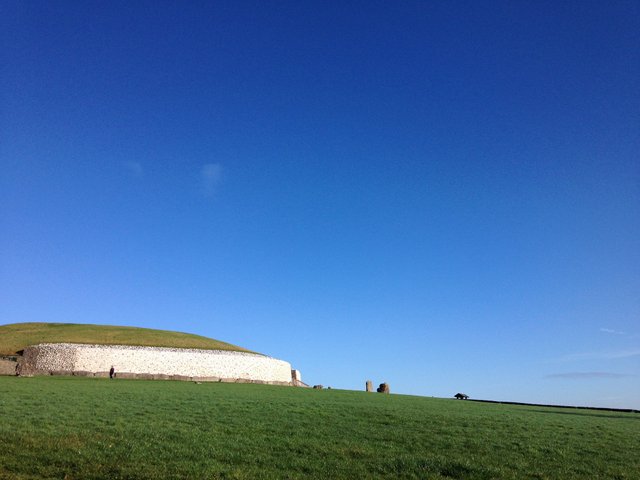
The morning was bright but cold, promising crisp February sunshine. In the Lagan valley, though, the mist was dense, and once the new toll road to Dublin sped us into the valley of the river Boyne itself, visibility was poor indeed. We left the motorway and navigated narrow country roads past picturesque cottages and plug-ugly bungalows, seeing only as far as the hedgerows. As the mist began to break up, liquid winter sunlight glinted off old fashioned road signs and the new brown tourist signs pointing to the site of the Battle of the Boyne.
I’d visited Newgrange once before, back in the early 1980s when Bruce Springsteen played a concert at nearby Slane Castle. Back then, we trusted our monuments to speak for themselves, and trusted ourselves to listen. The reconstructed stones stood in a field waiting for you to park up and stretch your legs. Now, more than 30 years later, you must buy a ticket at the visitors’ centre and wait your turn to be ferried by small bus to the site. But the centre is bright and informative, and if you have to kill time you can buy a coffee or walk out onto the path and bridge, and watch the Boyne snake through the misty sunlight.
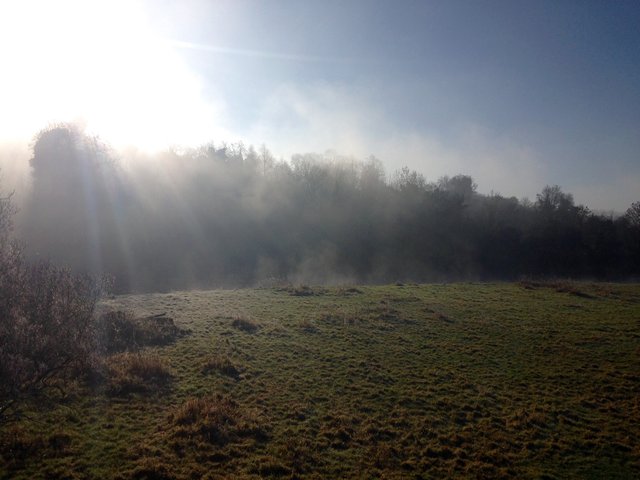
If you have heard of the Boyne, chances are it’s as the site of that small (on the contemporary European scale) but important battle of 1690, when forces loyal to the Catholic James II of Britain (and Ireland) were defeated by an army led by William of Orange, whose supporters had ousted James in the so-called Glorious Revolution. The river today doesn’t seem much of an obstacle, but under musket fire…?
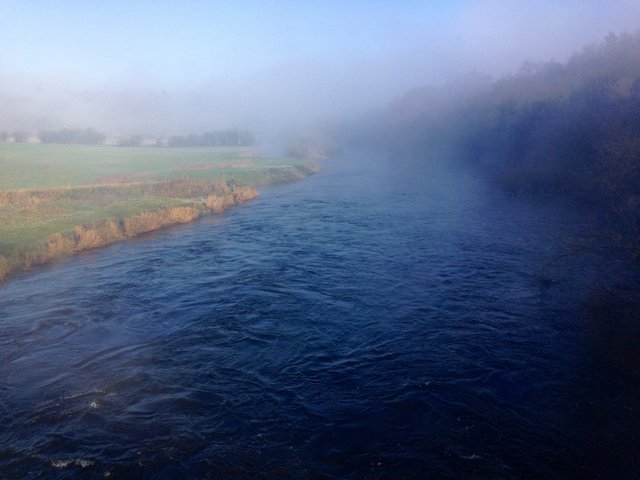
The monument itself is deceptively close; later, when the mist had finally cleared, we could see it on its low ridge from the windows of the visitors’ centre. But it wasn’t until the last moments of the five-minute bus shuttle that the sun came fully out and shone off the high revetment of white quartz.
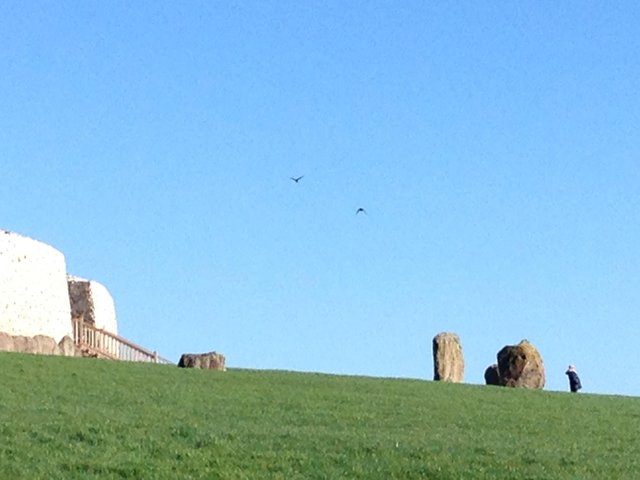
I’m not an archaeologist, and this account of the monument leans heavily on the World Heritage Ireland website (see the link below.) Newgrange seems to have been built towards the end of the fourth millennium BCE, somewhere around 3,200 BCE. That’s not long after the birth of writing and agriculture, older than the pyramids, and about the same age as the Ħaġar Qim megalithic temple complex on Malta that I mentioned earlier.
‘To the Neolithic culture of the Boyne Valley, the winter solstice marked the start of the New Year-- a sign of nature’s rebirth and promising renewed life to crops, animals and humans.’
(from the World Heritage Ireland site)
The structure is a large mound or cairn thrown up over a roughly-cruciform passage tomb. The mound is approximately 80m in diameter and is surrounded at its base by a kerb of 97 stones. The most impressive of these stones is the highly decorated Entrance Stone, whose triple spiral has become an icon of Irish prehistory.
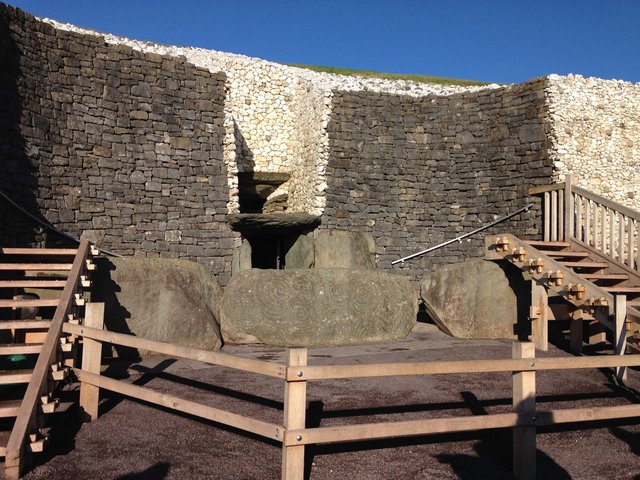
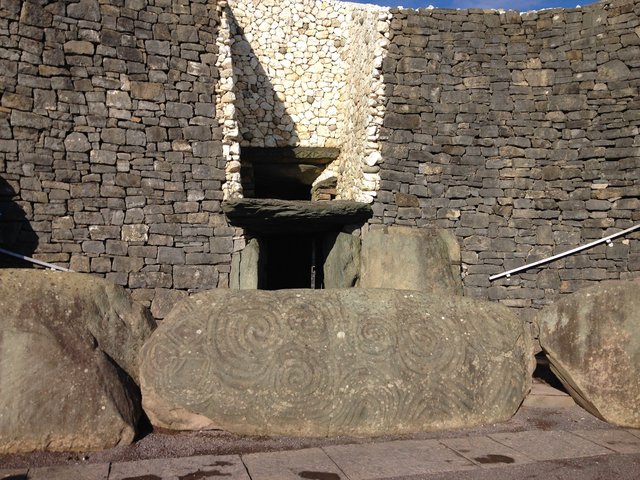
Beyond the entrance’s ‘door into the dark’ is a narrow - and low-ceilinged, so mind your head! - passageway leading to a chamber with three recesses, beneath a corbelled roof of overlapping greywhacke slabs sealed with a capstone 6m above our head. Photography isn’t allowed inside the chamber, so word-pictures will have to suffice: 16 of us, and our friendly guide, stood shoulder-to-shoulder in a conical space, with the stone roof narrowing above us. Here and there on the stonework we could see zig-zag and diamond patterns carved into the stone.
These basins which are on the floor of each of the recesses held the remains of the dead. The remains of at least five people were recovered during excavation, although originally much more bone may have been placed there. Most of the bones found were cremated, although small amounts were unburned. Grave goods of chalk and bone beads and pendants as well as some polished stone balls were placed with the dead.
‘Most of the bones found were cremated, although small amounts were unburned. Grave goods of chalk and bone beads and pendants as well as some polished stone balls were placed with the dead.’
from the World Heritage Ireland site
We’d missed the solstice by a month and a half, but carefully-aligned artificial light replicated the effect of the midwinter sun beaming through the gap above the entranceway and illuminating the chamber. (At least one archaeologist has suggested that this famous solar alignment may be a product of over-imaginative reconstruction work by an earlier generation, and not actually a deliberate feature of the neolithic structure.)
And once outside, the winter sun was still low enough to suggest that there could be some truth to the idea that the tomb - if it was simply a tomb - was aligned to the turn of the astronomical year…
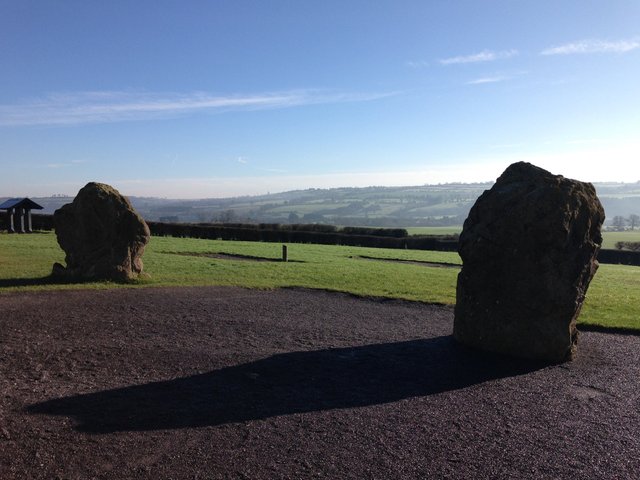
It is too easy to read our own ideas into the work of the ancient builders of artifacts like Newgrange - and its sister sites at nearby Knowth and Dowth. The rationalists among us are slow to give credit to the magical imaginations of these early proto-farmers, the first Irishmen and Irishwomen exploring the rhythms of the dank island. The romantics, on the other hand, the New-Agers and crystal-merchants, project their own cod-spirituality onto the unimaginable world of five thousand years ago.
As our guide wisely said, perhaps we should recognise that our opinions are, given the abyss that separates us from the builders of Newgrange, more or less meaningless. Perhaps we simply can’t understand, and need to accept and marvel at our incomprehension.
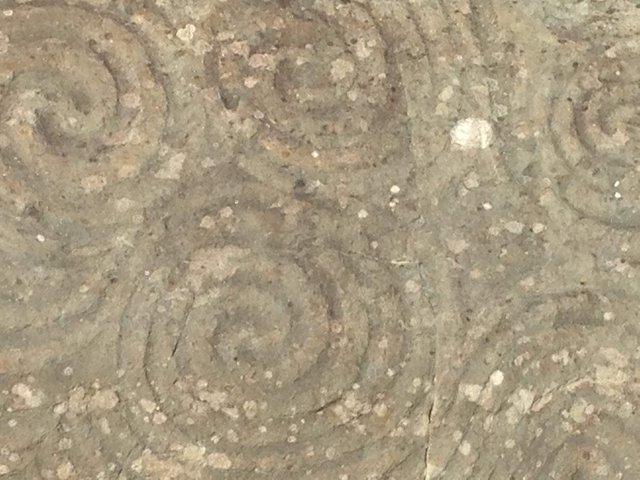
The official account of Newgrange’s Unesco World Heritage Status, and that of bru na boinne as a whole, including useful details of the wider archaeological and cultural landscape, see the World Heritage Ireland website. And if you’re planning a visit, or just want to find out about the area from another perspective, this site is a great place to check. The Irish Times
carried a brief account of recent controversy around the site. Wikipedia has a really thorough account of the site and its possible meanings, and the same site isn’t a bad place to start if you’re interested in the Battle of the Boyne - and why wouldn’t you be!? Finally, the BBC has good battle-related resources too.
Stay tuned for part 2, bringing this short tour of the Boyne valley into the medieval world...
Great post! The contrast regarding the amount of history there versus where I live is huge. Here in Phoenix, AZ it's difficult to find a building that's more than 60 years old.
Thanks for enjoying and commenting. Keep your eyes peeled for the follow-up - the Boyne valley has some amazing early and medieval Christian sites that I'll cover in a second article.
(What about pre-Columbian stuff in Arizona?)
nices and inspires pictures, i have a big hope to go there.